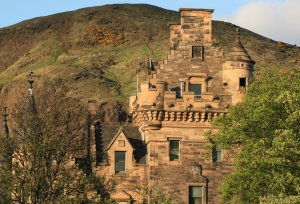Vacation Packages
Edinburgh vacation packages
Edinburgh has the largest collection of historic buildings, museums, art galleries and theatres of any city in Scotland.
Visit among other things the famous castle which started it all around three thousand years ago. Search out a host of hidden and historic treasures waiting to be discovered.

Edinburgh vacation packages

Edinburgh - History
Celts and Romans
When the Roman "Governor of Britain" Agricola advanced North in AD79 and reached the mouth of the River Esk at what is now Inveresk, he encountered the Celtic tribe of Votadinii. The Votadinii controlled the Forth River valley and based themselves at Dunedin . . . what is now probably Edinburgh Castle.
There is plenty of archaelogical evidence that the Roman army mixed on a day to day basis with the locals. After all most of the Roman army was made up of Celts (Gauls) from mainland Europe.
Although they fought, and defeated the Pictish leader Calgacus at Mons Graupius in AD84, the Romans could never master Caledonia and by 211 had retreated behind Hadrians wall, about a hundred miles to the south. By 410 they had left Britain for good.
The first United Scotland
By the sixth century four Kingdoms had developed in what is now Scotland;
To the North, the Picts,
To the far West, the Scots
To the West, the Britons
To the South-East, the Angles.
For the next two of hundred years these four kingdoms struggled, beset by Viking raiding parties , until in the 9th century the King of Dalraida, Kenneth MacAlpin, fought his way to something like a united Scotland. His Grandson, Duncan I, became the first King of Scotland in 1035.
Medieval and Renaissance Edinburgh
Although at this time Scottish rulers tended to base themselves further north across the Forth, King Malcolm III Canmore (died 1093) built his castle at Edinburgh, and his wife Queen (Saint) Margaret built a chapel within its walls - now the oldest building in the city. Her son, David I built the Abbey at Holyrood, a mile to the East along "The Royal Mile". Castle and Abbey became the anchor points of Edinburgh; a thriving town grew up along side the road between them, connected to Lieth, Edinburgh's port and trade-link to the world.
During the Wars of Independence Edinburgh Castle was captured by the English until Robert the Bruce's nephew, Thomas Randolph daringly recapture it by climbing its steep and craggy sides in the dead of night. Robert the Bruce granted Edinburgh a Royal Charter in 1329.
If Edinburgh did not grow outwards at this time, it did grow upwards. By the end of the 1500's it was established as the Capital of Scotland, and growing in population the inhabitants chose to build high houses close to the protection of the Castle: high tenement buildings most of which can be seen to this day.
When King James VI inherited the throne of England in 1603, Edinburgh ceased to be the principal site of the royal court, although it did continue to have its own Parliament.
Georgian Edinburgh
Everything changed after the Act of Union in 1707 . . . Parliament ceased in Edinburgh, but the city prospered. The loch below the North side of the castle was filled in. New streets and and thousands of houses were planned and built in the Classical fashion. (see map again) This period of energetic building during the "Enlightenment", which lasted into the 1800's, has left the city one of the most architecturally beautiful in the world.
To the present day
During the Victorian era expansion continued to grow, but the Old Town tenements around the Royal Mile declined into slums where poor people lived in cramped and insanitary conditions. Industry flourished in Glasgow, but Edinburgh remained the preserve of professionals, which it has tended to remain.
Since the last war its prestige has risen not least because of the establishment of the Edinburgh Festival In the 1960's the city was being torn down and rebuilt at an alarming rate , but fortunately the New Town Conservation Committee (formed in the 70's) put a stop to that. Buildings have been restored using traditional and sympathetic methods, and now the city looks as though it will remain as one of Europe's most beautiful and historically interesting living monuments.

Edinburgh - Culture
Three of Scotland's most important national galleries are all situated within walking distance of the city centre. Add to this the presence of a host of local gallery shops, The Edinburgh Art School, and various studio access facilities. Taken together this gives the city a great blend of the known and upcoming Art.
Museums in the capital also enjoy a wealth of depth. A mix of national Institutions and local city run establishments make sure your visit will let you come away with visions of Scotland's past.
As for the theatres and music Halls they need no introduction. During the festival weeks all are used to maximum effect attracting some of the worlds best performers.
All spheres of taste are catered for, providing the kind of range that many a city would be envious of.
Tags: Edinburgh travel guide, vacation rentals, hotels, package holidays, points of interest, car rental, city breaks, weather